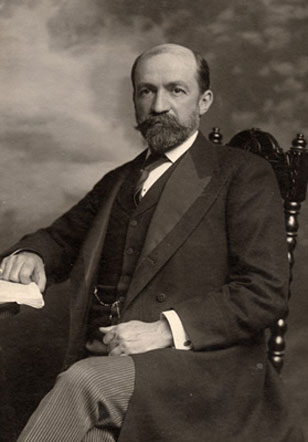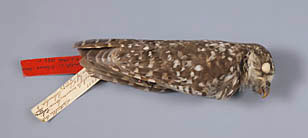Samuel Gibson Dixon
(1851-1918)

Samuel Gibson Dixon
Academy Archives, Coll. 457, 5120
Samuel Gibson Dixon, who served as Academy President from 1895 until his death, combined a visionary scientist’s inquisitive drive with an executive’s deft management skills. A pioneering bacteriologist, Dixon is perhaps best known for his work as head of the Pennsylvania Department of Public Health, where he introduced sanitary and hygienic reforms that set new standards for government public health programs and saved thousands of lives. In addition to building a groundbreaking state Department of Health, Dixon transformed the Academy from a “cramped, antiquated” institution into a “great modern museum”—as Academy ornithologist Witmer Stone put it in his eulogy—professionalizing research and curatorial roles which had previously been held by volunteers and amateurs, dramatically expanding the building, and modernizing the organization and upkeep of specimen collections.
Dixon studied law at the University of Pennsylvania, passing the bar in 1877 and working at his brother’s Philadelphia firm. After six years behind a desk, he began to find the work disagreeable and deleterious to his health. So at the age of 32, he embarked upon a new career: medicine. After graduating from the University of Pennsylvania Medical School in 1886, Dixon traveled to Europe, where he studied with some of the leading figures in bacteriology, a field which was then in its infancy. His focus was on epidemics—in particular, tuberculosis, which was then a devastating and incurable disease. He is now regarded as the first researcher to induce immune response to tuberculosis in guinea pigs—a precursor to the development of an effective treatment for the infection in humans—although the Nobel Prize-winning microbiologist Robert Koch, whose experiments postdated Dixon’s, was given credit at the time.

Burrowing Owl
(Spectyto cunicularia tolimae)
ANSP 35239, Holotype
After returning from overseas, Dixon was appointed professor at the University of Pennsylvania’s Medical School but left the job when academic responsibilities got in the way of actual research. The Academy of Natural Sciences offered an opportunity to conduct his tuberculosis investigations undisturbed, and in 1890, he was elected a member after being nominated by Joseph Leidy, one of the era’s most celebrated scientists. Dixon established a bacteriological laboratory at the Academy. As he became more and more interested in the mission and operations of the Academy as a whole, however, he once again embarked upon a new path. In 1895, after serving for several years as a curator, he was appointed President.
Under Dixon’s able management, the Academy rose to prominence as a center for research and modern scientific education. Dixon also successfully lobbied the state legislature for earmarked funding to enlarge and improve the museum. He fireproofed the structure, built a new library and lecture hall, and inaugurated a series of free public lectures for children and teachers.
In 1899, Dixon generously funded the purchase of skins collected by Dr. J.W. Detwiller in the vicinity of Bogota, Colombia ten years earlier. These 130 specimens were particularly important because the location of their capture was carefully recorded, providing indispensable information to researchers about the distribution of species.
In 1905, Dixon was appointed to head the fledgling Pennsylvania Department of Public Health, a position that he held until his death simultaneous with his leadership of the Academy. His accomplishments in public health are chronicled elsewhere, as he created what Scientific Monthly called “the largest and most efficient health department in any state of the union.”
There are at least two-dozen study skins in our Dixon collection from the 1880’s and 1890’s. They seem to be fairly evenly split between North American birds (from across the United States) and Colombia. Generally speaking, the specimens in this collection are larger sized birds (raptor and duck sized) or species that would be locally common where they were collected. Specimens such as these are the most commonly used in the collection and provide great insight into broad-scale ecological and biogeographic studies. There are three important type specimens from this series, Tropical Mockingbird, Mimus gilvus tolimensis (ANSP 35356) and the Burrowing Owl, Speotyto cunicularia tolimae (35239), collected on the plains of Tolima in Colombia, and Southern House Wren, Troglodytes aedon columbae (35354), collected near Bogota.
Samuel G. Dixon had a profound effect on the Academy. He helped guarantee the future of the Academy’s collections and the viability of research being conducted to this day.